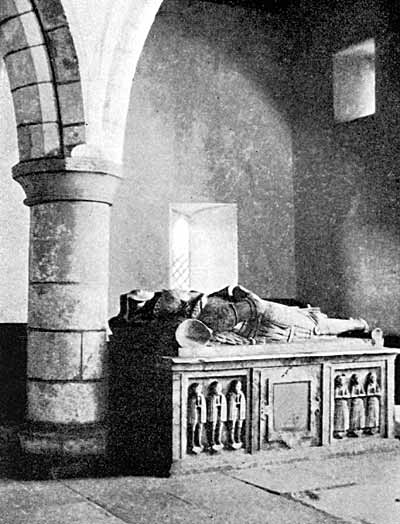MONUMENT No. 3.
Here lie the bodies of Henry Sacheverell, Esqr. and Iane his Wife, Daughter to German Irton, of Irton, in the County of Darby, Esqr. By whom he had issue 3 sonns & 3 daughtrs., Gervas, Henry, & Francis, Eleanor, Jane & Marie which Henry died the —of—. |
 |
| Radcliffe-on-Soar. Tomb of Henry Sacheverell (1580). |
The monument in line with the last commemorates the son of Henry and Lucy, and his wife Jane (Ireton). It was not set up until some time after the decease of the squire, as we may learn from testamentary burials, where it is recorded that it was done in compliance with the terms of his son’s will, who left £30 for the purpose.
In point of time therefore, this was the last of the series of table-tombs to be set up in this church, and it well illustrates the change that had taken place during the hundred years which elapsed between No. 1 and No. 3. The idealized features and christian symbols of a former generation have given place to stern matter-of-fact Cromwellian types, as witness the progeny—three males and three females represented on the tomb chest. The family arms are carved in bold relief and picked out with heraldic colours, separate shields for Sacheverell and Irton at the west end; the same arms impaled at the east end; the north side is now blank but it is plainly to be seen that it once carried a lozenge and a shield (now missing). The inscription panel on the south side, executed in gilded Roman lettering on black marble, or touch, has never been completed; but the omission of the date of decease may easily be accounted for. Civil War was abroad in the land at the time when this monument was in preparation. During the turmoil, church registers generally were neglected, and in many cases destroyed. The earliest burial entry still extant at Radcliffe-on-Soar, is dated 20th day of Januaire Anno Dom. 1624, and refers to Henry, son and heir of this man.
So then perchance when all the wars were done, there would be no one left who could supply the exact date necessary to complete the inscription—a condition of things by no means unusual in many parts of the country at that time.
With regard to the effigies; the squire is represented with pointed beard and moustache, while the features of the lady are also very distinctive. She was great-aunt to Major General Ireton, the regicide, and an interesting sidelight is thereby suggested.
When Ireton died in 1651, he was buried in Henry VIIth chapel at Westminster. A tomb was set up by the nation at a cost of £120, and William Wright “graver in stone to the Protector “supplied effigies of Ireton and his wife Bridgett (daughter of the Protector). The tomb was utterly destroyed at the Restoration. Was it in any way comparable to the monument to his great-aunt here at Radcliffe-on-Soar? and had William Wright any connection with the Nottingham alabaster men?
